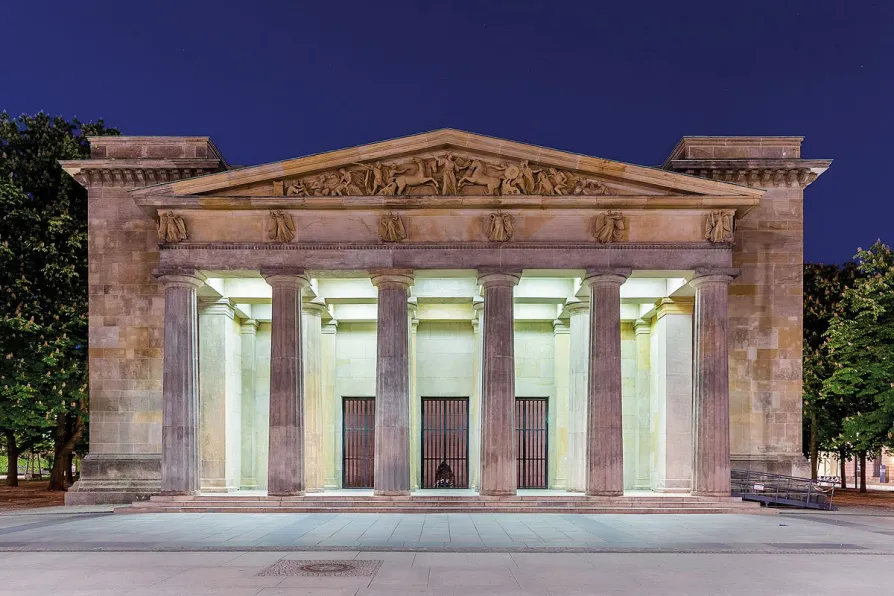The long-term effects of chemical weapons such as Agent Orange mean that the impact of war lasts well beyond a ceasefire
JOHN GREEN observes how Berlin’s transformation from socialist aspiration to imperial nostalgia mirrors Germany’s dangerous trajectory under Chancellor Merz — a BlackRock millionaire and anti-communist preparing for a new war with Russia

 CONTESTED HISTORY: The Neue Wache (“the New Watchhouse”) was rebuilt by the GDR in 1957 and reopened in 1960 as a Memorial to the Victims of Fascism and Militarism — then, in 1993, it was rededicated to the ‘victims of war and tyranny’
CONTESTED HISTORY: The Neue Wache (“the New Watchhouse”) was rebuilt by the GDR in 1957 and reopened in 1960 as a Memorial to the Victims of Fascism and Militarism — then, in 1993, it was rededicated to the ‘victims of war and tyranny’
WALKING around the centre of Berlin in glorious sunshine on May 2 this year, the 80th anniversary of the liberation of Berlin by the Red Army, I was struck by how much the city centre reflects recent history, but in a very incongruous way. As a visitor, you feel transported to an unreal place — a city of dreams and nightmares.
Berlin attained its apotheosis during the 18th and 19th centuries, as the capital of Prussia, reflected in its wide avenues, built for military parades, and bombastic, neo-classical buildings and palaces.
The city has been immortalised in so many works of art, including the 1927 silent film Berlin: Symphony of a Metropolis by Walther Ruttman, later by Christopher Isherwood in Goodbye Berlin (1939), a semi-autobiographical novel which inspired the musical Cabaret.
Friedrich Engels was not such a fan. In 1841, he did his military service there and hated this “most Prussian” of all cities. He wrote that “whenever I hear the name ‘Berlin’ I feel sand between my toes and the missing poetry of nature.”
On my first visit to the divided city in 1961, only weeks before the Berlin Wall cemented that separation, its streets were still disfigured by ugly ruins, shrapnel-splattered walls, and an aura of melancholy and dereliction hung like a miasma over it.
From the 1960s onwards, as the GDR grew in strength, there was a concerted attempt to rebuild the city with a mixture of historical restorations and a smattering of buildings that would reflect modern life and socialist aspirations.
That restoration work, alongside many new builds, was continued at an accelerated pace after unification, but with a very different architectural and political perspective.
Unification in 1990 offered the opportunity of creating a new Berlin to reflect a modern, forward-looking and unified nation. Instead, the city became a boom town for property speculators and a wet dream for those politicians yearning for a return to an era when Germany dominated Europe economically and militarily. This went in tandem with a determination to demolish any prominent buildings associated with the GDR and socialism.
During the late 18th and early 19th centuries, German architects like Karl Friedrich Schinkel and Andreas Schluter, among others, left their mark on the city. They drew their inspiration from Italy, but not from the cultural blossoming of the Italian Renaissance with its majesty, grace and delicacy, but from the Italy of the Romans with their emperors, military might and conquering armies of legionaries.
Schinkel’s edifices still dominate the architectural landscape of the city. His Die Neue Wache (New Guardhouse), a columned, neo-classical portico, stands prominently on Unter den Linden, alongside the Humboldt University.
It was badly damaged in the war but rebuilt by the GDR in 1957 and reopened in 1960 as a Memorial to the Victims of Fascism and Militarism. In 1969, the 20th anniversary of the GDR, a glass prism holding an eternal flame was placed at its centre. The remains of an unknown soldier and of a nameless Nazi concentration camp victim were entombed there.
The statues of two Hanoverian generals — Friedrich Wilhelm von Scharnhorst, atop a pedestal adorned with an aggressive Prussian eagle, and Friedrich Wilhelm Bulow — had stood alongside the Neue Wache but, as symbols of Prussian military conquest, had been removed by the GDR government.
After unification, in 1993, the Neue Wache was rededicated as the Central Memorial for the Victims of War and Tyranny (thus removing any reference to fascism). The GDR memorial piece was removed and replaced by a Kathe Kollwitz sculpture, Mother with Dead Son.
In addition, there has also been discussion about returning the statues of the two generals to their original position from where they had been removed by the GDR. The government of the united Germany was determined to eradicate any reminder of socialism, and instead resurrect its imperial past.
That Prussian military legacy is still dominant today. Along Unter den Linden, you promenade past grand columned and pedimented buildings. Coats of arms, incorporating the imperial eagles of the Hohenzollern era, adorn the porticos. Statues of great military men of the past stand steadfastly on ornate pedestals, decked out in togas or cloaks, swords in hand, along the wide avenues.
The Berliner Schloss (Berlin Palace) on the river Spree had been badly damaged as a result of Allied bombing during the second world war. The GDR decided to demolish the remnants in 1950. In its place, during the 1970s, the government built a modern “people’s palace” — a genuine community and cultural centre to be enjoyed by all Berlin’s citizens and which also housed the GDR parliament.
However, after unification in 1990, the Palace of the Republic was itself demolished in 2009, and the old emperor’s palace rebuilt. Today, it stands like a huge, stranded galleon, adjacent to Berlin’s massive baroque cathedral and the Museum Island.
The old blocks of workers’ flats have been fully renovated, their original Prussian facades restored, and in addition, numerous new, modernist apartments and offices have filled the many gaps left by the war. Previously bustling working-class communities, they are now owned by (West) German property developers and big international investors and house the more wealthy. Rents have soared accordingly, and gentrification has transformed the whole character of the city.
With the alarming rise of the far right in Germany and the increasingly loud banging of military drums by the new government under its chancellor and warmonger Joachim-Friedrich Merz, the military character of Berlin takes on an even more ominous significance.
As a young politician in the 1970s and ’80s, Merz was an active anti-communist. He is seen as a representative of the traditional Establishment conservative and pro-business wings of the CDU. He also advocates a European army and has just increased German “defence” spending to an unprecedented level.
His work as a lawyer and board member of various corporate boards, including the notorious BlackRock, has made him a multi-millionaire. His Russophobia is deeply ingrained, and he appears to be preparing his country for a new war with Russia.
The banning of Soviet symbols and Russian flags at the memorial to the Red Army in Treptower Park, as well as the brutal repression of pro-Palestinian demonstrations in the city, are additional signs of historical amnesia.
The shrapnel damage still visible on Berlin’s older buildings serves to remind us of the terrible cost of the war against Hitler’s fascism that took the lives of 27 million Russians and many Germans too. Merz appears to be indifferent to those historical lessons.














